What Is Affiliate Marketing?
Affiliate marketing is when an online retailer pays you a commission for traffic or sales generated from your referrals.
It’s essentially classic advertising in a less intrusive way. Rather than promoting a product on your website with visual advertisements, like this:
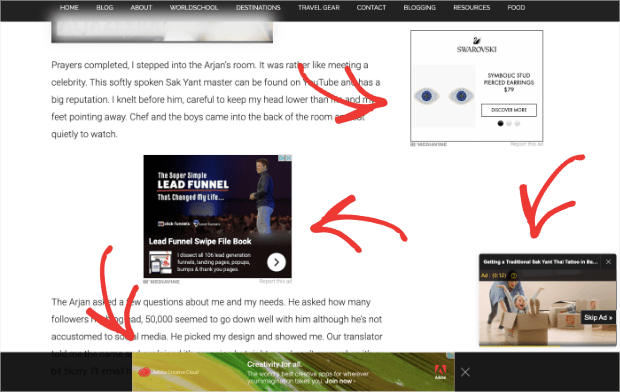
You simply embed the product link in your content, like this:

In the image above, the affiliate partner is Bluehost, a company that offers self-hosting services for websites.
So does that mean you can create a website, toss in a bunch of affiliate links, and watch the affiliate commissions roll in? Not quite, but we’ll get to that.
For now, you simply need to know the basics with how affiliate marketing works:
- You recommend a product or service to your followers through your website, blog, or email list.
- Your followers purchase the product or service using your affiliate link.
- You get paid a commission for the sales made using your affiliate link.
Let’s break down this process into more detail to make sure you know exactly how to make a successful affiliate marketing strategy.
But first, let’s quickly look at 2 things you need before starting out with affiliate marketing.
What You Need to Start Affiliate Marketing
There are 2 things you need to get started with affiliate marketing:
- Create a website or blog in your niche
- Choose affiliate products to promote
Let’s look at each of these in a bit more detail:
1. Create a Website or Blog for Your Niche
To make money with affiliate marketing, the first thing you need is a website.
When it comes to building your website, you have tons of options. But we highly recommend using WordPress.
With WordPress, anyone can quickly build a professional-looking website in minutes, even if you don’t know how to code:

Plus, WordPress has more tools to help their sites perform at a higher level than other website builders. That means more functionality across your site and a better user experience (UX) for your visitors.
If you’re interested in making money with affiliate marketing, WordPress is definitely your way to go. You can check out these tutorials if you need help building your site:
- How to start a WordPress blog
- How to make a website with WordPress (step-by-step-guide)
Now that your website is built, you’ll need to determine which products you want to promote. That takes us to the second prerequisite for starting out with affiliate marketing.
2. Choose Affiliate Products to Promote
If you’ve done the work to choose a niche, choosing affiliate products to promote should be easy. Choose products that fit your niche and relate to your content.
One of the best ways to select your affiliate products is by joining an affiliate network.
Affiliate networks are businesses that connect merchants and affiliate marketers so both can earn more money. Affiliate marketers use affiliate networks to make better product selections to promote on their site.
There are many affiliate networks out there, but here are a few of the most popular:
One of the benefits of affiliate networks is they typically have more data on how well a product sells. You can then use that data to increase your affiliate marketing profits.
For more information, check out our helpful post: Earnings-Per-Click: How to Win Big at Affiliate Marketing.
Anytime that you can make data-driven decisions rather than “going with your gut” is an excellent opportunity to optimize your affiliate strategy.
Ok, now that you have your website built and you know which products you want to promote, it’s time to dive into our exact process for making money with affiliate marketing.
Our conversion experts will design 1 free campaign for you to get maximum results – absolutely FREE! Click here to get started →
How to Make Money With Affiliate Marketing
Now that you have a website and joined an affiliate network, it’s the right time to start monetizing your site with affiliate marketing.
Let’s get started!
Step 1) Create Content That Generates Affiliate Revenue
In an effort to make money with affiliate marketing, most beginners simply publish some random content and insert affiliate links within the article.
That strategy may or may not work, but if you truly want to boost your affiliate revenue, you’ll need to make sure the content you publish reaches your target audience.
Your target audience is someone who wants to buy a product but not sure whether or not the product is worth it.
Sometimes, the user may not even know which product to buy for fulfilling their needs.

As an affiliate marketer, it’s your job to help users discover the right product for their needs with high-quality content, help them make a purchasing decision, and then navigate them to the product website for completing the purchase.
That means your article should be targeting investigational intent keywords — the type of keywords your target audience uses on Google to research about the product they want, right before making the purchase.
For more details, you can check out our guide on choosing the right keywords.
Step 2) Promote Your Affiliate Products in the Content
Now you know what kind of content you’re going to produce: investigational. You’re looking for topics that revolve around your target audience searching for an answer to the problem they’re facing.
Once you’ve done your keyword research and have your content ideas, it’s time to start inserting affiliate links in your content.
The way that you insert your affiliate links will depend on the specific article you’re writing. It wouldn’t make sense to add affiliate links to 5 different products if you’re doing a product review.
On the other hand, if you’re showcasing the “Top 10 Tools for Solving X,” you would want to put in multiple affiliate links to increase your chances of making more sales.
The goal is to insert your links as strategically as possible.
Here are a few tips you can use to get the most out of your affiliate links’ placement:
- Only link where appropriate: Don’t add an affiliate link if it doesn’t fit in your content. This will negatively impact the user experience (UX) and cost you more lost sales in the long run.
- Add links as early as possible: If you’re showcasing many products in one article, make sure you add your affiliate products at the top of the list. Most people won’t take the time to read an entire article. You want to make sure they see your affiliate links early on.
- Get more out of your site’s space: You can use floating bars, inline banners, and sidebar widgets to promote your affiliate products. These enhance the impact of your content and lead to more sales over time.
Here’s an example of affiliate links from a post by IsItWP on the best recipe plugins for WordPress:
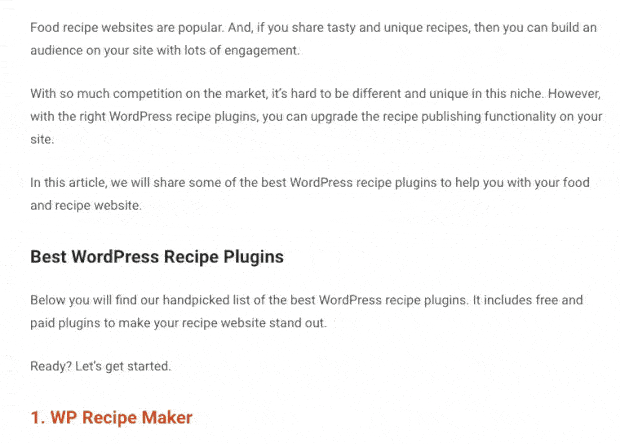
You’ll notice the list has many options, but the first few are affiliate links. This gives the user a chance to research all the options while increasing the odds that IsItWP’s affiliate links will be seen.
Again, you want to appropriately promote your links as often–and as powerfully–as you can.
Pro-Tip: Before you start adding hundreds of affiliate links across your site, invest in an affiliate link plugin.
Imagine having to sort through and update hundreds of expired affiliate links when you have no idea where you’ve placed them on your website.
You’re looking at hours of headaches and tons of wasted profit from expired links you’d forgotten about.

Fortunately, this is one nightmare that can be avoided with an affiliate management plugin. And one of the best ones on the market is Pretty Links:
![]() Pretty Links is an affiliate marketing management plugin that lets you keep better track of your affiliate links. It’s easy to set up, super user-friendly (even for less tech-savvy marketers) and allows you to put your marketing on auto-pilot.
Pretty Links is an affiliate marketing management plugin that lets you keep better track of your affiliate links. It’s easy to set up, super user-friendly (even for less tech-savvy marketers) and allows you to put your marketing on auto-pilot.
It also lets you cloak affiliate links to make them look short and neat so that it’s easy to share through emails and social media platforms.
And if the day ever comes where you’re asked to update old affiliate links from your partners, you’ll be able to accomplish it in minutes, not days.
Plus, if you do find you run into any trouble, they’ve got an amazing support team to help you at each step of the way.
Now that you’ve created the right kind of content and have strategically placed your links (while using an affiliate management plugin), it’s time to kick things up a notch with targeted conversion campaigns.
Step 3) Turn Your Visitors Into Affiliate Customers
One of the biggest mistakes new affiliate marketers make is assuming they need to 10x their traffic if they want to 10x their profit.
It actually doesn’t work that way, which is great news for you.
For example, let’s say that you’re promoting a product on your site that pays $50 as affiliate commission for every sale you make. And imagine that your affiliate conversion rate is 2%, meaning for every 100 visitors you send to that website, 2 of them are buying the product.
That means the CPC (cost per click) you earn is $1 per click.
(CPC = Total affiliate revenue / total traffic you sent)
But what if you could send 2X more visitors to the affiliate product site? Based on the CPC value, you could double the affiliate revenue as well. And the best part… you don’t have to increase traffic to your site. Instead, you could simply set up a conversion optimization campaign that boosts your revenue.
With a conversion optimization software, like OptinMonster, you can increase your revenue by converting more of your existing traffic into affiliate customers. Without a doubt, this is WAY EASIER than drastically increasing your traffic.
Here’s how OptinMonster could help you boost your affiliate income:
a) Create a Popup Campaign That Promotes an Affiliate Product
Like it or hate it… you can’t just deny the fact that popup works!
Creating a popup campaign is the easiest way to grab your visitors’ attention and convert more of your visitors into affiliate customers.
OptinMonster provides over 50 pre-built templates to help you make the right campaign for your affiliate product. From there, we offer many targeting rules and campaign triggers to make sure you’re showing the right message to the right people at just the right time in their customer journey.
In fact, this is the exact strategy Top 6 Digital used to increase their affiliate revenue by 30%.
They had a webpage on car seats to help parents choose the right one for their child. When the reader was leaving this page, the following campaign would appear on their screen:
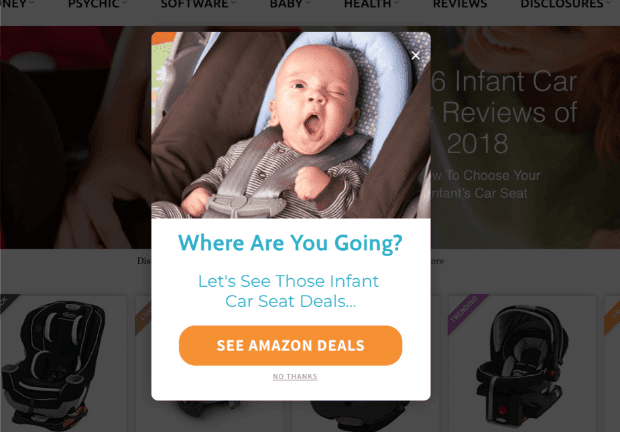
This simple campaign was hugely successful. It grabbed the audience’s attention and brought them to the affiliate product page.
b) Display Campaigns When Users are More Likely to Buy
When it comes to popup campaigns, targeting is really important. With the right targeting, you can show a popup campaign to the right users at the right time. For example, studies show that the best time to show a popup is when a user is about to leave your site.
With OptinMonster’s Exit Intent technology, you can show a popup that promotes an affiliate offer at the precise moment your users are about to leave.
Our customers use Exit Intent along with Page-Level Targeting and see massive results.
Page-level targeting allows you to create affiliate offers for specific pages on your site. So when a visitor is reading one of your articles, you can show them a campaign that highlights the EXACT affiliate product you’re promoting in that article.
Since the offer you promote in that campaign is highly targeted, it’s more likely to convert than a generic campaign.
The WordPress hosting company FlyWheel actually used page-level targeting to increase engagement by 660%.
Or take the fitness company Crossrope, for example. They grew their email list over 900% by catching abandoning traffic with exit-intent popups.
Step 4) Optimize Your Existing Traffic for More Revenue
This next step comes from a strategy that’s driven by something called “the 80/20 rule.”
The 80/20 rule, in this case, suggests that 80% of your profits will come from 20% of your content. It’s obviously not an exact metric, but the basic principle stands firm:
Identify your highest converting content and make it a priority for affiliate campaigns.
Once you know that a particular post or video is resonating with your audience, you can create a targeted campaign with OptinMonster to increase affiliate sales.
This is a much better plan of action than blindly making campaigns for every page on your site. How do you get started?
Jump into your Google Analytics dashboard, identify the articles that bring in the most content, and then create targeted campaigns for those URLs.
And if you really want to level-up your game, you should consider getting MonsterInsights:
MonsterInsights is the world’s #1 Google Analytics (GA) plugin in the world. Many marketers love the idea of gathering data from Google Analytics, but they get confused, annoyed, or intimidated by GA’s user interface.
Rather than letting all that valuable information go to waste each month, you can get the same data delivered straight to your WordPress dashboard. This includes a review of your site’s top posts:
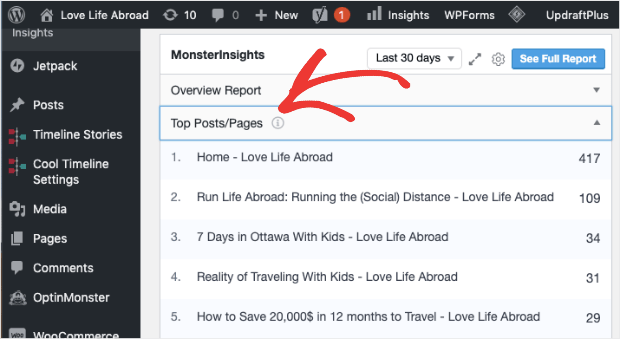
Once you’ve identified which posts bring the most traffic, you can optimize your content and conversion campaigns to generate more affiliate revenue.
This strategy will ensure that you’re always prioritizing your most profitable content. That means you can save time and increase revenue as efficiently as possible.
Step 5) Grow Affiliate Revenue from Your Email List
No matter how you look at it, email marketing is still the best way to earn passive income. All of the other methods fall short in some way.
SEO is great until Google changes its algorithm and your rankings tank. Paid ads can bring quick results if you have the budget to fail your way upwards. And even then, paid ads require constant care and attention to keep conversion rates high.
But your email list is traffic that’s always yours.
Plus, it’s full of people who have an interest in your niche and have already engaged with your content. That means you know they’re interested in your niche, and they’ll make for an excellent audience for your affiliate marketing campaigns.
Here’s the ONLY problem with email marketing: most business owners struggle to grow their contact list to the point where monetization makes sense.
That’s where OptinMonster comes in:
OptinMonster is hands down the best way to create conversion campaigns with popups, floating bars, fullscreen welcome mats, and more.
In the same way that you can use conversion campaigns to send traffic to your affiliate links, you can also use them to grow your email list.
You can create targeted popups, floating bars, fullscreen welcome mats, and more to entice your site’s traffic with lead magnets.
In exchange for these lead magnets, your users give you their email addresses. Here’s an example of an option campaign you can use to grow your list:
![]() Not sure what a lead magnet is or how to make one? Check out this post in 69 lead magnet ideas you can start using today.
Not sure what a lead magnet is or how to make one? Check out this post in 69 lead magnet ideas you can start using today.
Once you’ve built an email list, you can send automated campaigns with your affiliate links embedded in them.
Make sure that you read this post on how to create an affiliate email marketing campaign before getting started.
Whether you’re using your email list to drive more traffic to your high-converting posts or sending users directly to an affiliate link, email marketing is a great way to improve your revenue.
These are just a few of the examples of people who grew their list with OptinMonster. You can have similar results and make even more money with affiliate marketing.
We hope you found this article helpful.


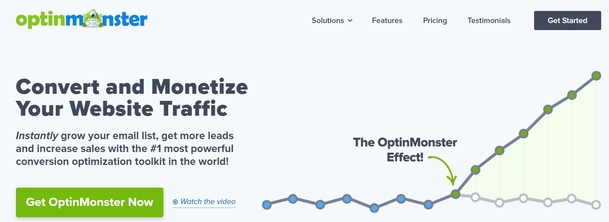
0 Comments
Please do not enter any spam link in the comment box.